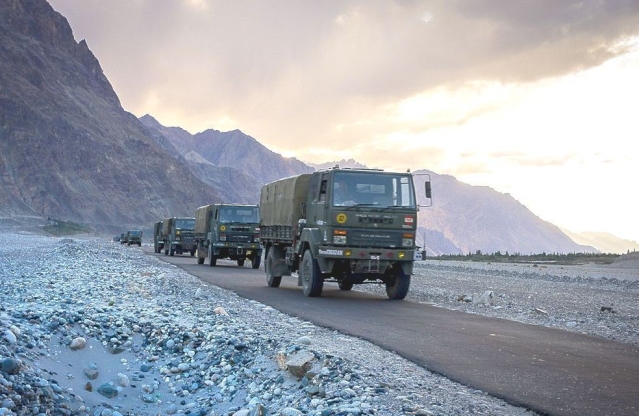Ambassador M. K. Bhadrakumar is of minority opinion in India. Nevertheless I've found his strategic and historical insights are striking and rare among Indian elites. Modi's government is not going to follow his advice, as Modi's rule is largely based on Hindu nationalism and much of Indian establishments are enamored by the trapping and luster of Uncle Sam's embracing. Their lack of long-term strategic vision is only matched by their ignorance of China.
---------------------------------------
Posted on
by
Indian Army convoy ferrying supplies to troops in Ladakh
The
by External Affairs Minister S Jaishankar in New Delhi on October 15 on the negotiations to resolve the military standoff in eastern Ladakh signal a cautiously optimistic estimation that there are serious proposals on the table and a breakthrough cannot be ruled out.
Jaishankar would have spoken only with a great sense of authority since every word he speaks on the matter carries resonance not only within India but regionally and internationally.
The chances of the 6-month old standoff ending appear good.
The pathway of constructive engagement that Jaishankar opened in September at his
with his Chinese Councilor and Foreign Minister Wang Yi in Moscow is advancing to its home stretch.
The first signs of the logical progression of the “Jaishankar line” appeared when a senior Indian diplomat joined the army commanders’ meeting
.
This brilliantly-conceived move not only continued into the last round of negotiations (7th round) in Chushul on October 13, but the Chinese Foreign Ministry followed the Indian footfall to depute a senior diplomat from Beijing to join the talks on Tuesday.
Equally, for the second time, the army commanders’ meeting issued a
.
Of course, some megaphone diplomacy has continued, for sure, but then, public perceptions are important.
Defence Minister Rajnath Singh’s loud speculation regarding the probability of a pre-conceived Sino-Pakistani “mission” to create tensions on India’s northern borders led the Chinese Foreign Ministry spokesman to respond that Beijing does not recognise Ladakh or Arunachal Pradesh as part of India, which in turn inspired the Indian spokesman to set the record straight that, no, Ladakh and Arunachal Pradesh are indeed integral parts of India.
Indeed, managing public perceptions will remain a serious problem, since a curious gang-up of interest groups is bent upon spoiling the broth that Jaishankar is cooking — Sinophobic ideologues in the media, a clutch of ex-faujis and ex-diplomats and the ubiquitous “Friends of Quad”. (Jaishankar’s remarks followed some alarmist media reports announcing with
that border negotiations with China have broken down.)
Meanwhile, Washington is watching with an eagle’s eye on the long-awaited Basic Exchange and Cooperation Agreement (BECA), which would be a rare foreign-policy trophy for President Trump’s campaign.
The BECA is a geospatial agreement that virtually ties the Indian armed forces to the American apron string — tantamount to the permanent stationing of an Edward Snowden in the sanctum sanctorum of Indian defence’s operational planning.
The US assumes that BECA could be the stepping stone to a de facto US-Indian military alliance.
A senior Chinese expert
last week that even if India were to sign BECA, it may not be on the dotted line and there could be “follow-up negotiations”.
No doubt, India’s China strategies are at a crossroads.
A breakthrough in eastern Ladakh leading to disengagement and creation of a buffer zone, will obviate the need of military deployment through the winter months ahead.
That would save a heavy drain on scarce resources at a time when Indian economy has shrunk by over 10 percent (according to IMF estimates) and the “first wave” of the coronavirus pandemic is yet to sweep through the country.
Clearly, in immediate terms, the national priority lies in ending the tensions in eastern Ladakh.
However, this momentum also can serve a larger purpose.
We must use any breakthrough for entering into a profound strategic communication with the Chinese leadership in search of a permanent boundary settlement.
Prime Minister Modi has three full years ahead before the general elections in 2024 to set his compass on the Sino-Indian boundary settlement and choreograph a new type of relationship with China.
So far, the apocalyptic predictions of the Sinophobes in India have gone haywire:
- No, China is not on an expansionist drive to grab Indian territory;
- No, China is not seeking a limited war with India;
- No, China is not seeking to broaden the scope of the limited standoff in Ladakh;
- No, China is not colluding Pakistan; and,
- No, China is in hopeless internal disarray due to Covid-19.
Our Sinophobes are whistling in the dark in their estimation that China is simply not interested in a boundary settlement with India but would prefer to leverage the border tensions to create pressure points for Delhi.
We need to stop believing in such soothsayers and instead test the Chinese intentions at the highest level of leadership.
In a historical perspective, the tragedy is that we didn’t do what successive leaderships in Moscow did — Mikhail Gorbachev, Boris Yeltsin and Vladimir Putin — in pressing ahead with a turbo-charged political thrust to settle the border problem with China and erect a new architecture on that foundation, attuned to what Germans call the
zeitgeist (spirit of the times.)
The Sino-Soviet border dispute was far more intractable than India’s dispute with China, as it involved Czarist Russia’s annexation of vast swathes of Chinese territories as late as the 19th century, which form part of Siberia and the Russian Far East.
But China took a pragmatic approach, prioritising the country’s economic growth and development.
The Russian prognosis of Chinese intentions turned out to be accurate.
And once the boundary settlement was reached, the Sino-Russian normalisation gathered pace and it has since proved to be of immense benefit to both sides, creating space for both countries to navigate the highly volatile contemporary world situation and to optimally leverage each side’s factors of advantage.
[snip]

